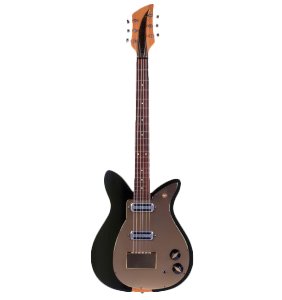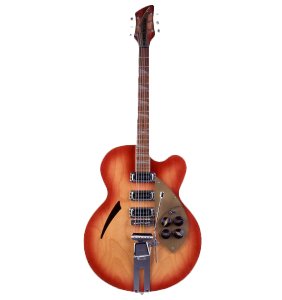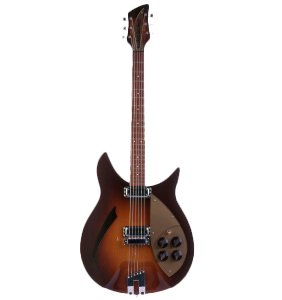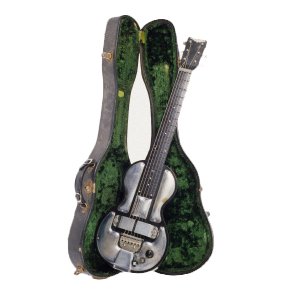In 1953, F.C. Hall (founder of Radio-Tel, Fender's original distributor) purchased Adolph Rickenbacker's Electro String Instrument Corporation, and re-named it after its founder. Work quickly began on a new line of Rickenbacker solid-bodies: the 'Combo' range. The first Combo model emerged in 1954, and the guitar in our photo, the tulip-shaped 450, made its debut three years later. Both the 450 and its single-pickup version, the 400, found favour with distinguished Belgian jazzman Toots Thielemans (b.1922), who used them while working with the George Shearing Quartet. The instruments were also admired by the young John Lennon (1940-1980); according to John C. Hall, who succeeded his father as Chairman and CEO of Rickenbacker in 1984, it was the sound of Thielemans playing a 'Tulip' that prompted Lennon to visit a Hamburg music store and order a Rickenbacker of his own - although the guitar he eventually acquired was not the 450, but the 'thin hollow-body' Model 325 he made famous with The Beatles.
In 1956, Rickenbacker celebrated 25 years in the guitar-making business; the company had used various names during this period, and, at its outset, had been known as Ro-Pat-In (see earlier article). It was now nurturing plans for an exciting and innovative range of electrics - the Capri series, later to be called the 300 series - that would attract international recognition, as well as high-profile customers from the world of pop and rock.
These guitars were designed by Roger Rossmeisl (1927-1979), a German émigré who had previously worked for Gibson. Rossmeisl took charge of the wood shop at Rickenbacker's Santa Ana factory, where he developed a variety of single- and double-cutaway, thin- and full-bodied models in an integrated 'house style' that made them instantly recognisable. The range divides into several separate types and classifications, though all Capri/300s share the characteristic sloping Rickenbacker headstock, and are made from maple, with rosewood fingerboards. The earliest one shown here is a natural-finish pre-1958 Deluxe. 'Deluxe' Rickenbackers, whether they are single-cutaway 'full-body' instruments, or thinner double-cutaway designs, all have triangular fingerboard inlays and bound bodies.
After 1958, the company began to use numbers and suffixes for its various Capri/300 models; the three-pickup single cutaway instrument in our photo dates from 1960, and was designated 375F. (Numbers from 360 to 375 were assigned to Deluxe models, and the 'F' stands for [thin] 'full-body.') Also illustrated is a Rickenbacker 330, made in about 1959: it is a 'standard' thin hollow-body guitar with dot fingerboard inlays and no binding.

RICKENBACKER COMBO 450, 1957
The twin-pickup Combo 450 appeared a few months after the 400 (a one-pickup model with the same body design). The 400 and 450 were thefirst Rickenbackers to have 'neck-through-body' construction, in which a singlepiece of wood is used for the entire centre section of an instrument, fromheadstock to tail. This 450 is finished in jet black; brown and green were alsoavailable.

RICKENBACKER CAPRI DELUXE, pre-1958
This guitar predates number-and-letter classification for Rickenbackers, but shares the specification of an 'F' (thin full-body) Deluxe series instrument. It has a 17-inch (43.2cm) body and is c.2.5 inches (6.35cm) deep. The 'slash' soundhole found on Rickenbackers is a distinctively 'European' feature, first used by the German Framus company.

RICKENBACKER 375F, 1960
A three-pickup thin full-body model incorporating a 'Vibrola' of the type developed by Doc Kauffman (later an associate of Leo Fender) in the 1930s. It was soon to be superseded by the more modern 'Ac'cent' vibrato unit.

RICKENBACKER CAPRI 330, c.1959
A 'standard' model (without binding or triangular fingerboard inlays) in two-tone sunburst. Its two pickups are single-coil 'chrome bar' transducers made and used by Rickenbacker until the late 1960s.
A key factor in the popularity of the Rickenbacker 300 series was their adoption by The Beatles: after John Lennon bought his Model 325 in Hamburg (see above), George Harrison (1943-2001) began to use a 12-string 360, and the prominent presence of these instruments on the band's early records - most famously, perhaps, the 12-string Rickenbacker chords on their 1964 single A Hard Day's Night - inspired American musician Roger (a.k.a. Jim) McGuinn (b.1942) to purchase his own 360/12 the same year. In 1965, The Byrds were formed (the group also included David Crosby and Chris Hillman), and their trademark sound, featuring McGuinn's new guitar, won them critical and commercial success on both sides of the Atlantic.
Roger McGuinn's Rickenbacker 360/12 can be seen opposite. Following its use on The Byrds' classic singles Mr. Tambourine Man and Turn, Turn, Turn (both 1965), it was sent back to the factory in 1966 for some modifications: surviving documentation shows that an extra pickup, a new nut, and a "pickguard with special wiring" were installed at that time. Roger McGuinn was photographed with the instrument before and after it underwent these changes; he subsequently sold it, and our picture of it was taken at a vintage guitar dealer's Hollywood premises in 1997.
The second Rickenbacker 12-string seen here bears John Lennon's name, and was produced as part of the company's limited edition Artist series. A 355/12JL, it is larger than the ¾-sized, vibrato-equipped 325 favoured by Lennon himself, but carries his replica signature and one of his cartoons, and forms a fitting tribute to a musician who played such an important role in popularising Rickenbacker's classic designs.

ROGER McGUINN'S RICKENBACKER 360/12, 1964
The 360 is 'officially' a two-pickup instrument; Roger McGuinn's guitar acquired its extra pickup and additional circuitry during a factory refit in 1966. Like all Deluxe Rickenbackers, it has triangular fret markers and a bound body. Note the ingenious 'compact' headstock design on both the 12-strings shown here; it disguises the six extra tuning machines by mounting them with their buttons facing downwards.

RICKENBACKER 355/12JL, c.1990
A limited edition guitar featuring reproductions of John Lennon's artwork and signature. It is one of Rickenbacker's full-size 'thin hollow-body' instruments, with a 15.25-inch (38.7cm) body width, and three pickups.

ELECTRO ES-17, 1968
The superb sheen on this Fireglo-coloured instrument betrays its origins as a re-labelled Rickenbacker Combo 425. The Combo series of solid electrics first appeared in 1954; the 'cresting wave' shape seen here made its debut four years later. Combos have been out of production since 1984.
The last instrument in this section dates from 1968, and its 'cresting wave' double cutaway, single pickup, overall shape and finish are identical to a Rickenbacker Combo 425's. However, it carries the 'Electro' label. Electro String was, of course, Rickenbacker's original manufacturing company, and for some years, the Electro marque was retained for instruments sold directly to teaching studios, usually as part of a beginner's 'outfit' that also included an amplifier and case. Rickenbacker boss John C. Hall explains that "Electro guitars were made in the same factory as Rickenbackers, and a lot of the models are the same [as] Rickenbacker models - except that they were not buffed out and polished to the same degree...to keep the cost down." Occasionally, though, an Electro instrument would be out of stock when required; then an equivalent, highly polished Rickenbacker, like the one in the photo, would have its original logo replaced, and be sent out as an Electro. According to Hall, this 'conversion' process sometimes worked in reverse: "Through the years, many people have taken Electro guitars, buffed them out, and put Rickenbacker nameplates on them - but [the instruments] didn't leave the factory as Rickenbackers!"